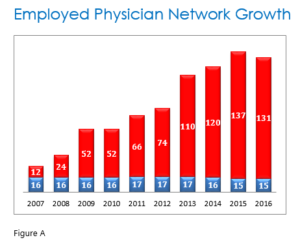Challenge
The employed medical group of a highly successful hospital system in northeast Ohio requested assistance with catalyzing enhancement of its physician leadership and charting its future course to ensure success in the evolving healthcare environment. Specifically, the administration desired to promote collaborative group function, appropriately enhance the network infrastructure, improve practice operations, cultivate physician leadership, and develop a more homogeneous group culture and identity.
Background
The group experienced significant growth during the previous decade – particularly from 2012 through 2015 – as demonstrated in Figure A. Much of the growth occurred through practice acquisition. With 146 physicians and 46 Advanced Practice Professionals (APPs) spanning 19 specialties practicing in 37 locations spread over 6 counties, the management infrastructure did not keep pace and experienced considerable strain. The medical group’s practices functioned in a semi-autonomous fashion – essentially continuing much of the operational processes that were in place prior to the practices’ acquisition. Though signage initiatives were being introduced to create a common identity, the group was not functioning in a common or homogeneous fashion.

In 2015, recognizing the need to effectively communicate with the growing group, the health system chartered a committee of physician leaders to enhance bidirectional communication. This committee was not conferred defined leadership expectations outside of effecting a communication chain. The medical group and health system leadership presented the medical group’s quality, patient satisfaction, and financial data to committee but there was a disconnect regarding development of specific action plans or creation of execution expectations.
In mid-2016, the health system and medical group administrative leadership undertook a consultative partnership with HSG to catalyze the group maturation process by developing a vision and potential strategies that would best position the employed medical group for continued success as the healthcare environment evolves.
How HSG Helped?
To accomplish these objectives, HSG conducted interviews to determine perceptions of the current status and future course. Fifteen key physician leaders, the informal nurse practitioner leader, and four key members of the medical group’s administration were interviewed. In addition, select leaders with insight into the medical group’s functionalities completed a formal electronic assessment of the group against 67 targeted best practices to objectify their perceptions.
Results and Impact
To date, the medical group has experienced the following outcomes:
- Engaged physician leaders in the Leadership Council and they became active participants in the group decision-making process
- Added APP representation to the leadership process
- Created Leadership Council subcommittees devoted to conducting the detailed work in
- Quality and Patient Experience
- Clinical Informatics
- Finance and Operations
- Injected desired physician and APP involvement with operational issues – including policy and procedure development and operational standardization
- Addressed several issues identified with the group’s management infrastructure
- Enhanced revenue cycle function which increased patient revenue capture and improved the medical group’s financial status
- Created the foundation for developing a more cohesive group culture
The Leadership Council and medical group administration continue to utilize the shared vision and associated strategies as a roadmap toward the medical group’s heightened continued success.
